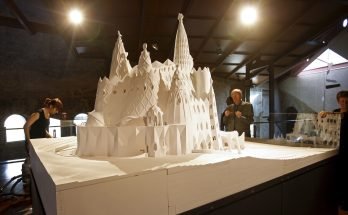|
|||||||||||||||||||||||
|
|||||||||||||||||||||||
FIVE MODELS RECREATE WHAT THE UNFINISHED CRYPT OF THE COLONIA GÜELL WOULD LOOK LIKEFive models, created by the universities of Innsbruck (Austria) and Moscow (Russia), show what the unfinished Crypt of the Colonia Güell of Antoni Gaudí, would look like, declared a World Heritage site by Unesco, and they form part of the permanent exhibition created to mark his centenary. | |

The professor in the history of construction and heritage of the University of Innsbruck, Rainer Graefe, has coordinated and directed the elaboration of the models which will be permanently installed in the Diocesan Museum of Barcelona, where they can be visited from tomorrow and which were presented at a press conference. The Innsbruck professor highlighted the laborious process carried out over the course of ten years to produce the five models which reproduce different aspects of what Gaudí’s work would look like finished, whether the interior, the exterior or some details of each. In order to create models, made with different materials, it was first necessary to produce a project in three dimensions on the computer, to thereafter create them with a computerised milling machine. The laborious process of elaborating these models is reflected in the permanent exhibition by means of images, videos and smaller models. Rainer Graefe has stated that the works presented today are “a reflection of the apparition of modern architecture and a revolutionary construction system, the funicular model”, an innovative method created by Gaudí to carry out his work. The Crypt, located in Santa Coloma de Cervelló (Barcelona) was begun in 1908, but its construction was stopped in 1914 upon the death of its sponsor, Eusebi Güell, due to which only the lower part of the church was built, the part which contains the crypt, while it is the top part that remains unfinished. All the original models of this work were destroyed in 1936, which gives an idea of the difficulties encountered by the academics in reconstructing what Gaudí’s project would look like completed. Rainer Graefe explained that the reconstruction was a laborious job which it was possible to carry out because they had eighteen images of Gaudí’s project, amongst them photographs of the funicular model created by the architect, as well as drawings produced by the artist himself. Graefe explained that a funicular model is a “revolutionary system used by Gaudí, which combined a type of construction with an imaginative architecture thereby achieving aesthetic beauty.” The funicular model consists in fixing a wooden board to the ceiling, upon which the top view of the building is drawn, and from the load-bearing points – columns and wall intersections - drawstrings were hung from which, in turn, little weight sacks were suspended which produce the resulting catenary curve, both for arches as well as domes. This innovative system created by Gaudí was used in the Colonia Güell Crypt as well as in the Sagrada Familia and with it the classic conception of the perfect circumference comes to an end, breaking the arches with straight sections. The Austrian professor has severely criticised the reconstruction of the Crypt carried out by the Diputación de Barcelona (Barcelona County Council) and the Ministries of Culture and Promotion, under the direction of the architect Antoni González. In his opinion, “the junction lines between the land and the crypt” have been destroyed as, according to Graefe, “Gaudí’s temple is organically integrated into the hill it is located upon.” Source: lavanguardia.es | |
|
|